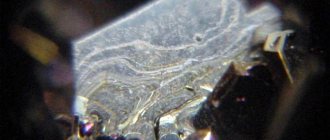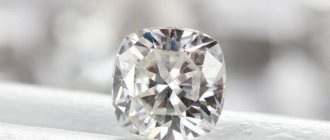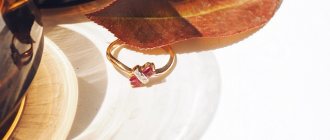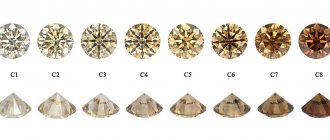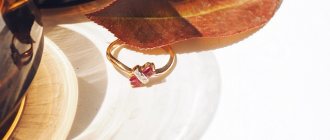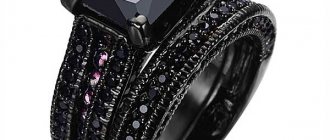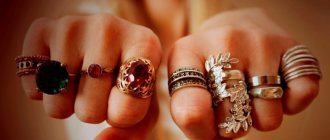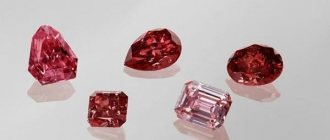What is moissanite
The name is given to a rare carbide mineral, which is colorless, shiny crystals. Gemologists, explaining what kind of moissanite stone it is, focus on the similarity of the structure with technical and synthetic jewelry samples. Natural gems are found in small quantities in individual meteorites, some corundum deposits, and kimberlites. The size of natural stone is a few millimeters. In laboratories, moissanites are grown large enough and of high quality so that they completely replace diamonds.
Most of the silicon carbides on the market are laboratory-made stones. The natural crystal was first found in 1893 in Arizona in a meteorite. Then it was possible to discover tiny hexagonal plates in the body of the meteorite. The name of the stone was given in honor of the meteorite researcher Henri Moisson. Even then, scientists doubted that the crystal was real, suggesting that it came from a researcher’s saw.
Heavenly Stone
History of moissanite
The Canyon Diablo meteorite fell many thousands of years ago in the US state of Arizona. In 1893, the French chemist Ferdinand Frederic Henri Moisson began to actively study this cosmic guest. This is how the scientist first discovered the smallest fragments of a completely new mineral, which was later named moissanite in his honor.
The formula for the production of a synthetic analogue was patented by Edward Goodrich Acheson on February 28, 1893. He invented powdered silicon carbide (SiC), and as a result not only established large-scale carborundum production, but also invented a furnace in which the synthetic material is still produced today. Edward Atcherson became the founder of specialized.
Story
The mineral moissanite is extremely rare on the planet, so it is considered heavenly. It is found in ancient meteorites that arrived in our planetary system from others. On Earth and even on our luminary, conditions are insufficient for a crystal to appear naturally. It turned out that such rock is formed near giant stars and during supernova explosions. In 1905, the gem was found in an Arizona meteorite while studying fragments of a celestial stone. Moisson, who was involved in this work, soon received the Nobel Prize. The new rock he discovered was dark green and splintered. Subsequently, similar ones were found inside diamonds and in several heavenly stones.
For a long time, the properties of the gem attracted geologists, but it was not possible to produce an alternative in laboratories. It was only by 1982 that the composition was studied well enough to think through the technology. The creation of large colorless crystals was realized in 1998. From this moment on, large jewelry samples are made in quantities that satisfy the industrial sector. Gemologists often call a rare mineral a jewel of the 21st century.
Guest from meteorites
Carborundum production
The simplest way to produce stone is to sinter silica with carbon. This happens in a special oven, which was mentioned above, at very high temperatures - 1600–2500 °C.
Here I would like to mention one more feature of synthetic moissanites - they are very refractory and can withstand temperatures of at least 1500 °C (diamond burns at 800 °C).
In addition, there is Lelya’s method. At 2500 °C, silicon carbide sublimates and deposits at lower temperatures on the substrate in the form of high-quality flake crystals. This process can be further improved by using induction heating in graphite crucibles.
Today, the main supplier of moissanite is the American company Charles & Colvard. Refined over two decades, our patented manufacturing process creates stones that exhibit incredible brilliance and clarity.
The company also emphasizes ethics and environmental responsibility, which are integral to the creation of moissanites.
Physico-chemical characteristics
Main properties of a precious gem:
- colorlessness (or yellow, green, black color);
- greenish-gray streak;
- diamond shine, sometimes turning into metallic;
- transparency;
- hardness up to 9.5 units;
- unclear cleavage;
- axonal syngony;
- refraction up to 2.967 units.
Jewel of the 21st century
An artificial analogue of a diamond is superior to its relative in terms of jewelry quality and physical properties. Moissanite is brighter, sparkles stronger, and refracts light a quarter better than a natural cut diamond. The play of light is more intense, a rainbow appears even in low light. The only thing in which a gem is inferior to a diamond is hardness (9.5 versus 10).
Stone cost
Natural moissanite is a very rare and therefore expensive nugget. Synthesizing large stone crystals also makes them expensive.
Also read: Clinochlore - unique properties of the stone
However, the actual cost of the mineral will depend on its size, transparency and uniformity of color, color and the quality of the cut itself. Eg:
- a colorless artificial faceted stone of 1 carat (about 6.9 mm in diameter) will cost about $300;
- a green or blue stone of 1 carat is much cheaper - $240-250;
- 1 carat specimens in black, cognac or yellow – $220-230.
Of course, the cost of moissanite is lower than that of diamond, but small (up to 2 mm) stone chips will be more expensive than diamond chips of the same size.
Deposits and processing
Moissanite is extremely rare. There is a chance of finding a natural sample in the following deposits:
- Ermakovskoe (Murmansk region);
- Emerald mines of the Middle Urals;
- Popigaisky crater in the Krasnoyarsk Territory;
- Uakit, Oshurkovsky massif in Transbaikalia;
- Udachnaya, World in Yakutia;
- Ust-Khannyinsky intrusion, Murunsky complex in Yakutia;
- Krivbass in the Dnepropetrovsk region;
- Pokrovo-Kireevskoye in Southern Donbass;
- Zhamanshin crater in Aktobe region.
Natural specimens are very rare
Comparative characteristics of diamond and moissanite
Two sparkling minerals - moissanite and diamond - are visually difficult to distinguish between each other. Apart from external similarities, they have practically nothing in common:
- First of all, they have different chemical compositions: diamond is carbon, and natural moissanite is silicon carbide.
- In addition, although the cosmic mineral has high hardness, it is still inferior to its precious rival.
- Moissanite, unlike diamonds, shines brighter due to double refraction of rays and higher dispersion. The transparency of the crystals and the play of light are at the maximum level. And this quality is primarily important for jewelry making.
A cosmic gem mined in nature has a fairly high price. This is explained by the fact that it is extremely rare in natural conditions. At the beginning of the 20th century, the production of artificial moissanite was established, which is not inferior in beauty to natural stone.
And it can be an excellent substitute for diamonds.
This synthetic analogue is inferior to expensive diamonds only in price.
This condition makes the mineral very popular among both women and men.
Of course, for connoisseurs of natural gems, the difference in the cost of stones is not a decisive indicator, so such a comparison can be considered very conditional.
Production of synthetic moissanite
A jewelry crystal of natural origin is almost impossible. The deposits contain grains up to 4 mm in size. Known deposits can yield single gems. To solve the demand problem and fill the market with quality specimens, scientists have developed a method for making crystals in the laboratory. Colorless specimens and those colored in golden, yellow, green, and black shades are created. They weigh 0.01-14 carats. The smallest ones are used in paths and halos. In the descriptions of some earrings and rings you can see a mention of large moissanites - they are used to decorate the central part of the jewelry.
Commercial cultivation of stone used for jewelry was launched in the mid-90s of the last century. Charles and Colvard began production, but the monopoly did not last long. A decade later, the market was flooded with products from Russian, Indian, and Chinese laboratories. Now there are several large companies filling the international market with high quality samples. The leader is the American enterprise 3D-sorch, where the key technologists working with moissanite were Soviet emigrants. It is based on the Leili method developed by Tsvetkov and Tairov. Work begins at room temperature (silicon carbide sublimates into crystals) and continues when heated to 2400 degrees. A 200 gram crystal with excellent shine and hardness can be grown in just 15 hours.
An alternative production is the crystallization of liquid raw materials, distillation from steam into liquid and then into a solid. The second option requires silicon-containing methane.
Russian scientists have produced grey-green transparent crystals by sublimation under elevated pressure. For now, the method is used as an experimental one.
Jewelry is made in laboratories
How to distinguish from cubic zirconia
Cubic zirconia is an industrially produced mineral that has no natural analogue.
To distinguish it from moissanite, the thermal water content is checked - the indicator is much lower. Externally, cubic zirconia and gemstone are similar, so density and hardness are checked for diagnosis.
How to distinguish moissanite from diamond
It is very difficult to distinguish these breeds on your own. It is recommended to contact a specialist to evaluate the sample on the equipment.
Unusual valuable mineral
The gemologist will check:
- hardness (moissanite is slightly lower);
- purity (carborundum is higher due to its artificial origin);
- dispersion (carborundum has 2.5 times more);
- birefringence, presence of double ribs;
- heat resistance (moissanite changes color when heated at 65 degrees).
A laboratory stone is almost as good as a natural diamond.
How to distinguish from a fake
Although moissanite is often used as an imitation of diamond, unscrupulous sellers sometimes deliberately hide this fact, passing off moissanite as a more expensive diamond.
Reference! A diamond is a well-cut diamond.
You can distinguish between a diamond and moissanite using an optical method using an X-ray, microscope or dichroscope. This method is the most reliable and safe for stones.
Also read: Melanite - a type of garnet
Among the differences between the stones are:
- hardness on the Mohs scale – diamond is harder;
- moissanite shines brighter:
- the color reflection of diamond is dominated by cold shades, while that of moissanite is dominated by iridescent shades;
- moissanite has no internal defects;
- moissanite absorbs UV rays, due to which it turns bright red-orange under ultraviolet light;
- When checked by x-ray, a diamond changes to green, yellow, blue or red.
In addition to optical methods, stones can also be distinguished by methods of compression, weighing, heating the surface with fire, electrical conductivity and Hodgkinson. However, these methods are used only by gemologists - firstly, this requires special equipment, and secondly, heat treatment and strength testing destroy the stones.
Reference! A diamond does not change color when heated, while moissanite begins to turn green over a flame.
Also, stones can be distinguished from each other by growth zones using a magnifying glass, microscope and lamp. Moissanite has more rounded growth lines, while diamond has zigzag curves or other unusual shapes.
Stones without a setting can be tested with water - an artificial moissanite will float, but a diamond will sink.
Moissanite and diamond
Although artificial stone is usually inferior to natural stone, transparent moissanite is an exception. It is no different from a diamond in appearance, only slightly inferior in hardness, and refracts light much better. Among artificially produced stones, the diamond analogue is the most expensive.
Price is one of the advantages of natural stone. A diamond is a good investment whose value increases over the years. True, it is very difficult to get the full price when selling jewelry; it takes a lot of time.
Laboratory stone is not inferior to natural stone
Jewelry market experts advise choosing a natural diamond if you need a small stone, and moissanite for those who need a large specimen. Jewelry with a laboratory gem is ideal for events with a large number of participants, where the product can be lost. If an accident occurs, the losses will be relatively small.
Areas of application
Both natural and artificial stones have a great resemblance to a diamond, while a diamond is harder, less fire-resistant, and is slightly inferior in beauty to its counterpart. This is why moissanite is highly valued by jewelers and collectors.
Also read: Citrine is a golden amulet of light and kindness
In addition to jewelry, artificial stone is widely used in industry. With its help they make:
- abrasive tools;
- covering sections of body armor;
- composite armor;
- protection of devices from overvoltage;
- transistors;
- diodes, semiconductors, sealing parts;
- telescopic optics;
- heating elements;
- disc brakes;
- diesel filters.
In addition, it is a catalyst for the oxidation of hydrocarbons and is used for the synthesis of graphene and in nuclear energy.
How to care
With improper, irregular care, the gem loses its shine. To return it, they check for damage. You won’t be able to restore the crystal’s beauty on your own, but you can worsen the condition with unprofessional actions, so it’s better to immediately take the specimen to a jeweler. Using special equipment, he will check internal and external damage and process the jewelry with a laser. Microcracks are filled with special glue.
Store moissanite in a special box separately from other items so as not to scratch it.
If dust appears on the stone, wash the jewelry with soapy water, wipe it with alcohol, and with jewelry napkins made of non-woven material. It is forbidden to rub the object with force; use vinegar, potassium permanganate, or hydrogen peroxide for cleaning. If the contamination is severe, the item is taken to a jeweler for ultrasonic cleaning.
The stone requires maintenance
How to wear
Jewelry with moissanite is ideal for an evening or formal dress, classic and romantic style of clothing. At the same time, the stone should always be in sight. For example, if these are earrings with a stone, then the hairstyle should be high, revealing the lobes. It is better to combine dresses with open shoulders and a neckline with a necklace. There should be no sleeves with bracelets, but gloves with rings.
Pendant with stone
And under no circumstances should you combine moissanite with ornamental stones and other gems.
Magic properties
Artificial stone has healing, magical properties
The gem influences human consciousness and supports in difficult periods of life. Breed:
- protects;
- calms;
- expels phobias;
- increases self-confidence;
- gives determination;
- helps to choose a direction;
- contributes to achieving goals.
Moissanite is a source of positive energy that protects against the evil eye.
Magical and healing properties
It is customary to look for magical properties in stones so that they become decorations and talisman. Some pass through the centuries and become family heirlooms.
This will not happen with moissanite. It was born in a laboratory in a few hours, which means it is empty. He did not lie in the ground, did not absorb its power, was not filled with the energy of the cosmos.
Natural stones have been formed over thousands of years. It is a product of rapid changes in the earth's crust. Stones are witnesses to the history of the Earth from its very inception. Their appearance is a miracle and a whim of nature. Synthetic ones appear thanks to human intelligence and perseverance. If we look at it from this point of view, we can say that moissanite is a symbol of intelligence and work. An explanation will reassure, but will bring nothing.
A talisman made from moissanite will not work.
The emptiness must be filled. Same with stone. The person who wears it can give it energy themselves. Good or evil will depend on the person.
If you wear moissanite and think about good deeds, enjoy life, then it will become a good amulet, and you will gradually begin to share this with others. Decades later, this stone can be made into a relic.
If the stone witnesses sad, evil or wicked thoughts, then good will not be expected from it.
Natural moissanite has a whole range of characteristics. If you can find it, the stone can be used to solve difficult life situations. It helps to find answers to insoluble questions and get out of difficult situations. It is important that the talisman helps you make the right choice.
With him, the character becomes light, carefree, and easy to communicate with.
Most moissanites came from outer space, so they can reveal extrasensory abilities in the owner and develop intuition. Under its influence, a person becomes wise and perspicacious. An understanding of the meaning of life comes.
